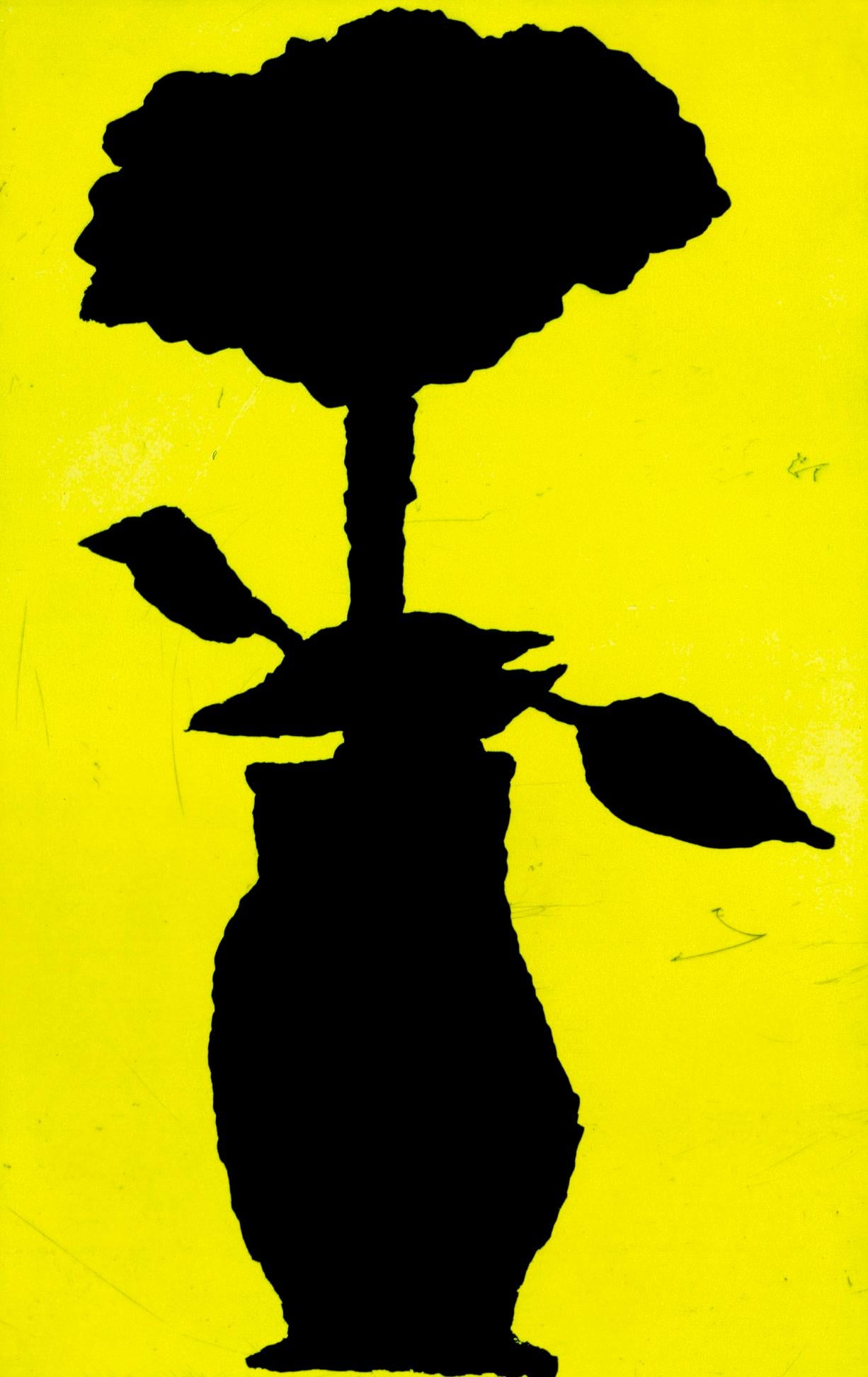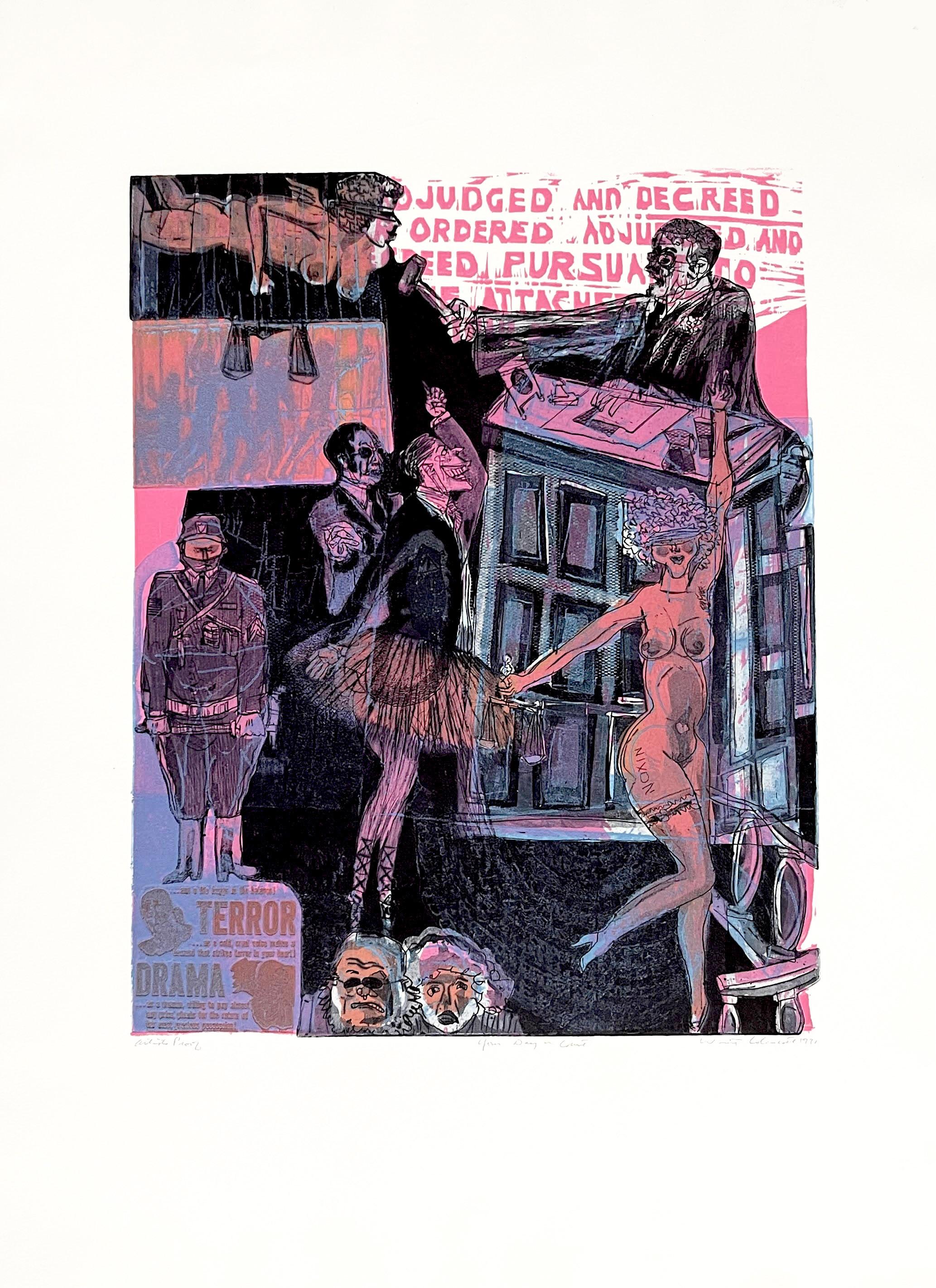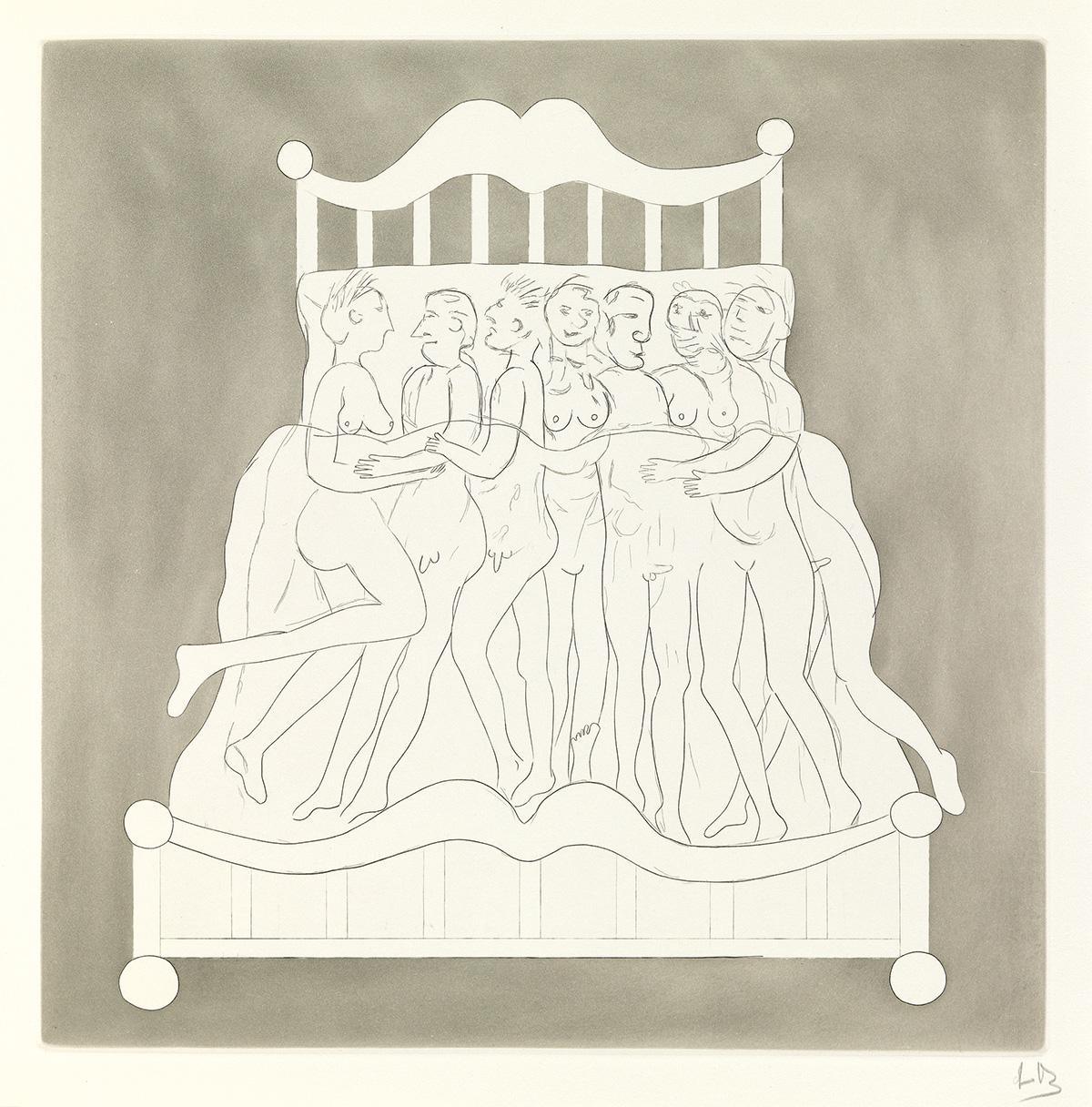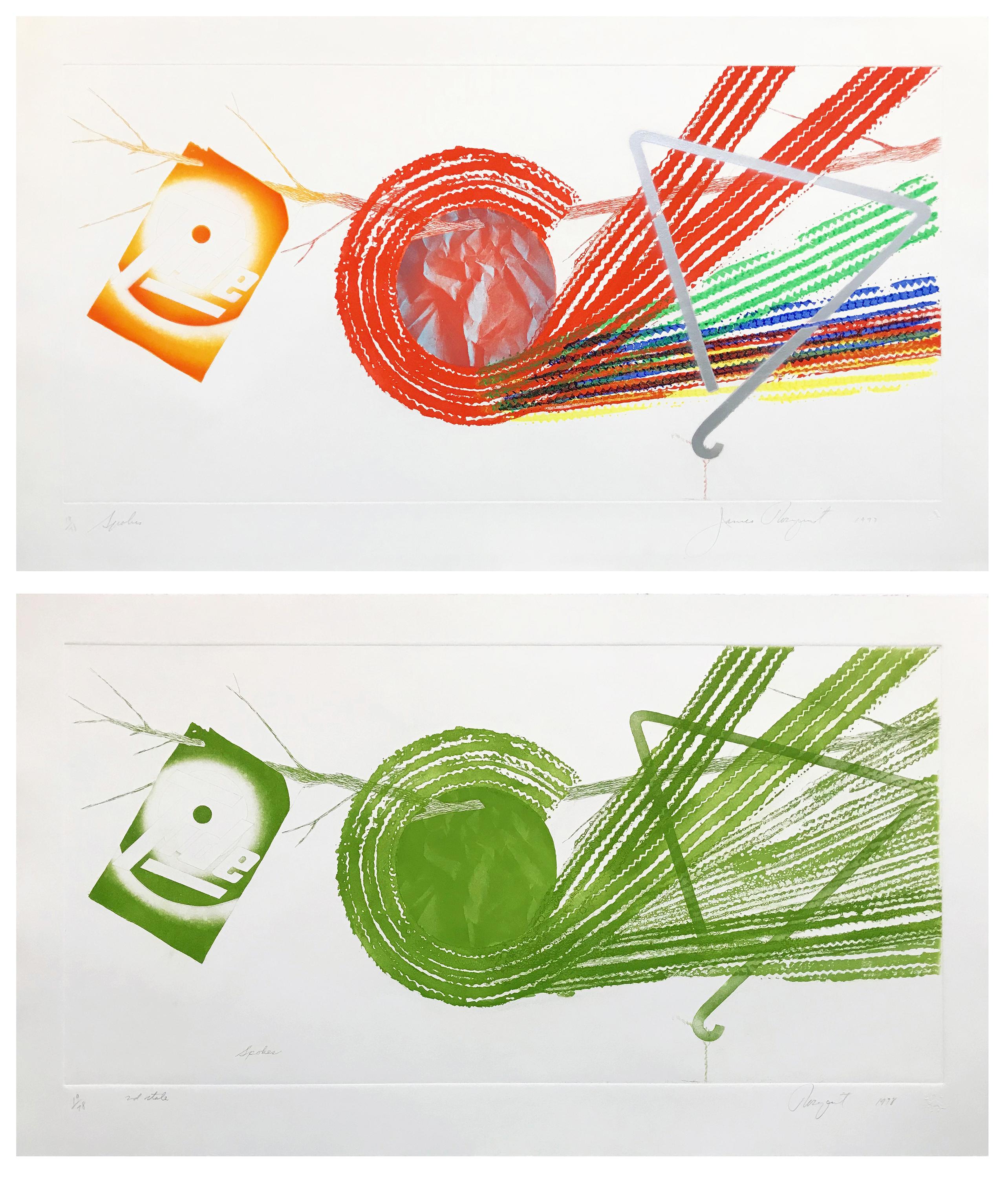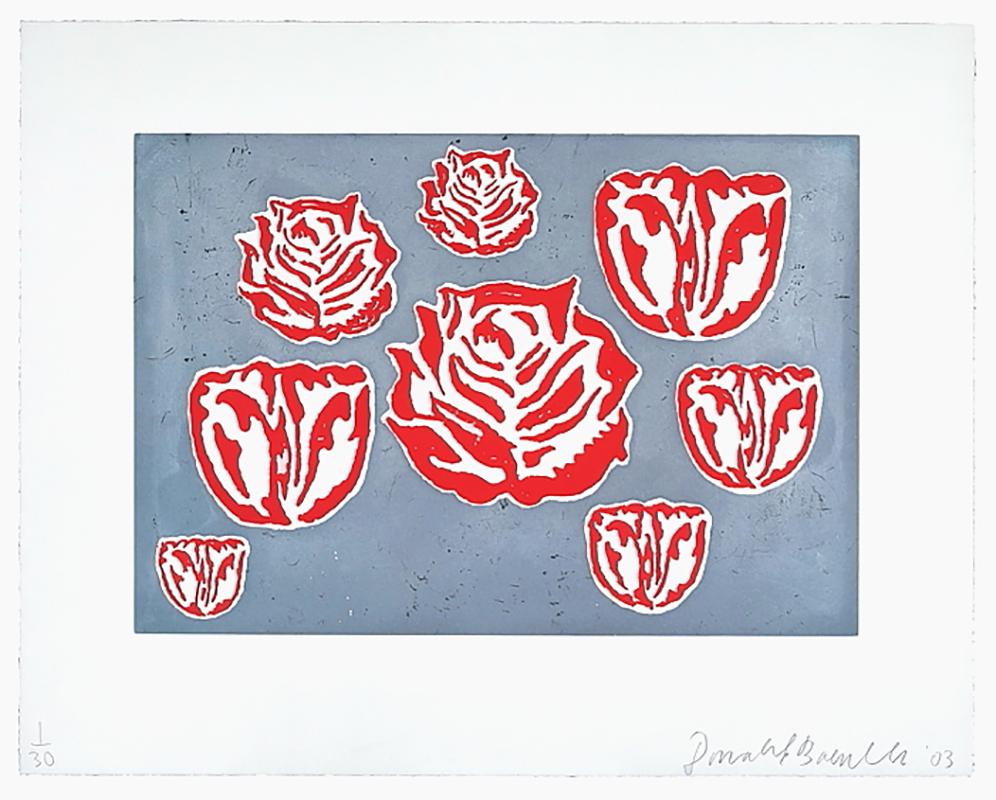Items Similar to American Dream (EAT / DIE / HUG / ERR) (Sheehan 136) UNIQUE Proof Love Food Life
Want more images or videos?
Request additional images or videos from the seller
1 of 7
Robert IndianaAmerican Dream (EAT / DIE / HUG / ERR) (Sheehan 136) UNIQUE Proof Love Food Life1986
1986
About the Item
Robert Indiana
American Dream (EAT / DIE / HUG / ERR) (Sheehan, 136), 1986
Hard and soft-ground etching, aquatint, drypoint and stencil on white Arches paper
37 inches × 21 inches
Hand signed, numbered, titled and dated on the lower right front in graphite pencil
Published by Vinalhaven Press, Vinalhaven, Maine; Printed by Anthony Kirk, Vinalhaven Press, Vinalhaven, Maine
Catalogue Raisonne Ref: Sheehan, 136
Unique - Historic
Unframed
The is a unique proof of Robert Indiana's important 1986 etching, aquatint, drypoint and stencil on Arches paper entitled "American Dream". The words read simply "EAT/DIE/HUG/ERR" - expressing basic humanistic activities - and recalling Indiana's 1963 etching "ERR 123" - both being some of the few etchings Robert Indiana did in his career. This print is a Unique proof - the Vinalhaven Proof, (publishers proof) from Robert Indiana's press in Vinalhaven Maine where he moved to after leaving the New York art scene. It is annotated in pencil VP 1/1 (Vinalhaven Proof, 1 of 1.) When Robert Indiana set up Vinalhaven press to print the works that he personally felt were important to make. This was one of them.
This proof is aside from the regular edition of only 10 - an incredibly rare and elusive regular edition. A most desirable Robert Indiana; a one-of-a kind piece for true Robert Indiana graphic collectors.
- Creator:Robert Indiana (1928 - 2018, American)
- Creation Year:1986
- Dimensions:Height: 37 in (93.98 cm)Width: 21 in (53.34 cm)
- Medium:
- Movement & Style:
- Period:
- Condition:the work has been previously framed, so there are remnants of mounting hinges on the back of sheet which will frame out; otherwise in excellent condition.
- Gallery Location:New York, NY
- Reference Number:1stDibs: LU1745213929642
About the Seller
5.0
Platinum Seller
These expertly vetted sellers are 1stDibs' most experienced sellers and are rated highest by our customers.
Established in 2007
1stDibs seller since 2022
289 sales on 1stDibs
Typical response time: 1 hour
- ShippingRetrieving quote...Ships From: New York, NY
- Return PolicyA return for this item may be initiated within 1 day of delivery.
More From This SellerView All
- Your Day in Court, from the portfolio Wisconsin GraphicsBy Warrington ColescottLocated in New York, NYWarrington Colescott Your Day in Court, from the portfolio Wisconsin Graphics, 1971 Drypoint, etching, aquatint, woodcut, & soft-ground etching, w roulette, vibrograver, letterpress ...Category
1970s Modern Figurative Prints
MaterialsDrypoint, Etching, Aquatint, Woodcut
- ERR (Sheehan 29)By Robert IndianaLocated in New York, NYRobert Indiana ERR (Sheehan 29), 1963 Photoengraving and Etching on off-white Rives BFK paper Hand signed, dated and annotated on lower front with artist's blind stamp from Coenties ...Category
1960s Pop Art Abstract Prints
MaterialsEngraving, Etching
- Deluxe Signed Edition of Film Festival Lincoln Center (Feldman & Schellmann, II.By Andy WarholLocated in New York, NYAndy Warhol Deluxe Signed Edition of Film Festival Lincoln Center (Feldman & Schellmann, II.19), 1967 Silkscreen, die-cut on opaque acrylic Edition 2/200 (Signed and numbered on the back with engraving pen) Hand-signed by artist, As this work was done on acrylic, Warhol signed and numbered it by hand on verso with an engraving needle. Stamped and dated with copyright Frame included: Elegantly framed in a museum quality wood frame with UV plexiglass. A die-cut window has been created in the back of the frame to reveal Warhol's incised signature and edition Publisher: Leo Castelli, New York Printer: Chiron Press, New York Catalogue Raisonne: Feldman & Schellmann, II.19 This work is often hung and displayed both vertically and horizontally - see photos for inspiration This work is one of only 200 done on opaque acrylic rather than wove paper, signed and numbered on the opaque acrylic by Andy Warhol with an engraving pen. (Separately, there was an unsigned edition of 500 on wove paper). What distinguishes this rare, extremely desirable signed edition of 200, other than that it is signed and numbered by hand by Andy Warhol, is that the black graphic text FIFTH NEW YORK is placed directly over the text Film Festival of Lincoln Center; whereas in the edition of 500, the text black text FIFTH NEW YORK is placed on top of the white text. An innovative feature that appears in this special edition is a perforated line running across the surface of the print, at its triangular cut out sides, mimicking the tear line present in real commercial movie admissions tickets. Chiron Press commissioned by Lincoln Center, devised a special process expressly to imprint the edition with this perforation using a die cut stamp. This work is quintessential early Warhol, with characteristic bright neon colors, featuring text, along with the artist's very recognizable flower motif. The Lincoln Center ticket simultaneously reflects Warhol's central preoccupations with commercial culture (the ticket is, par excellence, an object that is bought and sold), as well as his fascination with Hollywood - as the ticket, quite literally, represents an entree into the world of film. Warhol's appropriation of the flower - an otherwise sentimental and decorative motif, transforming it into a symbol of the Pop Art movement, is a hallmark of his early style and innovations. Andy Warhol's vibrant vintage color silkscreen Lincoln Center Ticket from the fabulous Sixties is considered one of the more iconic and recognizable Warhol images. It is also one of Warhol's earliest prints. The Vera List...Category
1960s Pop Art Abstract Prints
MaterialsPlexiglass, Screen, Engraving, Mixed Media
- Golden Gate BridgeLocated in New York, NYPeter Saul Golden Gate Bridge, 1968 Five color lithograph on German etching paper with deckled edges with collectors press chop mark Hand signed, titled and numbered "Artist Proof" lower front; also bears Collector's Press chop mark, and chop mark of master printer Tony Ko Frame Included: floated and framed in the original wood frame Provenance: from the Estate of the legendary California artist, Roy DeForest Accompanied by a copy of the publisher's documentation sheet (see image) This work is one of three hand signed Artist's Proofs, aside from the regular edition of 50. It is one of Peter Saul's most celebrated prints; the not so subtle at all symbolism speaks for itself, such as the gigantic dollar sign and wagging tongue (money talks loudly), set against San Francisco's iconic Golden Gate bridge. This print does not often appear on the market, as so many from this edition are already in the permanent collection of major museums and institutions. Other examples of this work were featured in the exhibitions: "Print Retrospective, 1966-2010", from September 16 – December 22, 2011 at the Carl Solway Gallery in Ohio, and "Peter Saul: Prints and Drawings, 1960 -1975", from February 26 – April 11, 2009, at The George Adams Gallery...Category
1960s Pop Art Abstract Prints
MaterialsEtching, Lithograph
- Beautiful Girl IIBy Tracey EminLocated in New York, NYTracey Emin Beautiful Girl II, 2011 Etching, with chine-collé on 300 GSM Somerset paper, with full margins Signed and numbered 52/100 on the front in graphite pencil; also titled by ...Category
2010s Pop Art Abstract Prints
MaterialsEtching
- Historic invitation poster for 1970 ACE Gallery exhibition Minimalist light artBy Dan FlavinLocated in New York, NYDan Flavin Rare invitation poster for 1970 ACE Gallery exhibition, 1970 Letterpress and stencil on colored paper Not signed Frame included Floated in the original ACE gallery vintage wood frame. Measurements: Framed: 17.75" x 17.75" x 1.6 inches Poster: 16 inches x 16 inches Extremely uncommon letterpress and stencil poster designed by Dan Flavin on the occasion of his 1970 exhibition “Two Cornered Installations in Colored Fluorescent Light from Dan Flavin” at the legendary Ace Gallery in Los Angeles. The poster, like most exhibition invitations of that era (including those from the Leo Castelli gallery in New York) was undated, as these works were so much of the moment. This work was acquired directly from the collection of the ACE Gallery. Other than the present work, we've never seen another example of this collectors item anywhere in the world, on or off the market (If anyone is aware of others, we'd love to see!) More about the legendary ACE gallery, and the sale of some of its art collection from the bankruptcy estate, from where the present work was acquired: ACE Gallery founder Douglas Chrismas opened his own frame shop and gallery in Vancouver at the age of 17. His gallery became known as a venue where Vancouver artists could show alongside major New Yorkers, and get the feeling of belonging to a bigger scene. In the 60s and early 70s he brought artists such as Robert Rauschenberg, Carl Andre, Sol LeWitt, Bruce Nauman, and Donald Judd to Vancouver, Canada. The gallery expanded to Los Angeles in 1967 at the former Virginia Dwan Gallery space in Westwood, and then further expanded to New York in 1994. The galleries were noted for doing museum-level exhibitions by up and coming and internationally renowned artists. While in New York the gallery’s presence was amplified by doing exhibitions in conjunction with cultural institutions such as the Guggenheim Museum and the Cartier Foundation (Paris). Under Chrismas' directorship, ACE Gallery has had either offices or galleries in art centers outside of the United States, such as Mexico City, Paris, Berlin. and Beijing. In 1972, Chrismas mounted Robert Irwin’s installation Room Angle Light Volume at the first ACE/Venice, which opened at 72 Market Street in 1971. In 1977, ACE mounted exhibitions of work by Frank Stella and Robert Motherwell, along with Michael Heizer’s Displaced/Replaced Mass. Installed at ACE/Venice, the Heizer piece required that huge chunks be gouged out of the gallery floor to create recessed areas able to accommodate boulders. In April 2016, ACE Gallery emerged from a three-year bankruptcy proceeding under the leadership of Sam S. Leslie. In May 2016, founder Douglas Chrismas was terminated from all roles at the gallery. In July 2021, Douglas Chrismas was arrested by the FBI and charged with embezzlement. In May 2022, Douglas Chrismas was ordered to repay 14.2 million in ACE art sale profits, which were diverted to personal accounts. Chrismas is awaiting criminal trial in January, 2023. He faces up to 15 years in prison if convicted. Controversies In a 1983 lawsuit in Los Angeles federal court, Rauschenberg sought $500,000 from Chrismas' Flow ACE Gallery; the artist won a $140,000 judgment in the suit in 1984. Eventually the two reconciled their differences and in 1997 Robert Rauschenberg insisted that ACE Gallery New York (in conjunction with the Guggenheim Museum) host his Retrospective. In 1986, Chrismas pleaded no contest after Canadian real estate developer C. Frederick Stimpson alleged that he had improperly sold work belonging to the collector, among them pieces by Andy Warhol and Rauschenberg. Under the terms of the settlement, Chrismas agreed to pay Stimpson $650,000 over a period of five years. He continues to work with the Stimpson family in handling their art interests. In 1989, ACE Gallery wanted to borrow a work by Judd along with Carl Andre's 1968 Fall, both owned by Count Giuseppe Panza, for an exhibition devoted to minimal art called The Innovators Entering into the Sculpture. Rather than shipping the two large scale works from Italy, Panza authorized ACE Gallery to refabricate the pieces in Los Angeles. In Panza's collection archives, there is a series of signed certificates signed by Judd that granted Panza broad authority over the works by Judd in his collection. These certificates "authorized Panza and followers to reconstruct work for a variety of reasons," as long as instructions and documentation provided by Judd were followed and either he or his estate was notified. This even included the right to make "temporary exhibition copies, as long as the temporary copy was destroyed after the exhibition; and the right to recreate the work to save expense and difficulty in transportation as long as the original was then destroyed." Miwon Kwon, in her account of site specificity: "One Place After Another," presents the account of ACE Gallery recreating artworks by Donald Judd and Carl Andre without the artist's permission. Andre and Judd both publicly denounced these recreations as "a gross falsification" and a "forgery," in letters to Art in America, however, the fabrication of the pieces were permitted by Panza Collection in Italy, the owner of the works. Despite the confusion surrounding the Panza refabrications, both Carl Andre and Donald Judd maintained a professional relationship with Douglas Chrismas and ACE Gallery. Andre showcased works at ACE Gallery in 1997, 2002, 2007, 2011 and present day. In 2007, Carl Andre's show entitled "Zinc" was exhibited at ACE Gallery in Beverly Hills. Donald Judd paid a visit to The Innovators Entering into the Sculpture exhibition at ACE Gallery and agreed to keep his sculpture in the exhibition. After the exhibition was over, Chrismas planned to sell the metal used for the re-fabrication of Judd's work for scrap metal but Judd wanted to own the re-fabrication for himself. ACE Gallery then sold the re-fabrication of Donald Judd's work to Donald Judd. After having consigned more than $4 million worth of art to ACE Gallery to sell in 1997 and 1998, the sculptor Jannis Kounellis filed a lawsuit in Los Angeles Superior Court in 2006, accusing Chrismas of keeping most of the profits of artworks and refusing to return the pieces that did not sell. According to the lawsuit, the primary agreement between Kounellis and Chrismas was oral. Chrismas returned all of Kouenllis' artwork, and did a full accounting of the proceeds from Kounellis' work—minus the expense of exhibiting it. The matter was resolved between the two of them and ACE Gallery still sells and exhibits Kounellis' work today. By 2006, Chrismas had filed for Chapter 11 bankruptcy protection at least six times since 1982, barring most of his creditors from collecting the money immediately owed to them. Chrismas filed for Chapter 11 bankruptcy to protect the gallery's extensive real estate holdings from the problematic landlord. The landlord of the Wilshire Boulevard space, Wilshire Dunsmuir Company, claimed that ACE owed back rent and penalties however, the claim was disputed by Douglas Chrismas. In court papers, Chrismas Fine Art claimed that it would cure "the pre-petition" debt by Feb. 1, 2000, and was asking the court to protect its right to remain in the property. A declaration filed by Douglas Chrismas characterized this leasehold as the business' primary asset. -Courtesy Wikipedia About Dan Flavin Dan Flavin (1933–1996) was a pioneer of Minimal Art. He rose to fame in the 1960s with his work with industrially manufactured fluorescent tubes, inventing a new art form and securing his place in art history. The exhibition at the Kunstmuseum Basel focuses on his works that are dedicated to other artists or make reference to certain events. Back in 1963 Dan Flavin mounted a single, industrial fluorescent light tube at a 45-degree angle to the wall of his studio declaring it art; the act was radical, and it still is. Indeed, it was owing to this action that standard commercial products would be introduced into art: The nascent Minimal Art of the era emphasised seriality, reduction and matter-of-factness. Somewhat ironically, while the autodidact Flavin never himself sought membership to this movement in art, he would, and quite literally, go on to become one of its most illustrious exponents. Flavin began work with fluorescent light tubes from the early 1960s on; arranged in so-called ‘situations’, he would then further develop them into series and large-scale installations. The colours and dimensions of the materials he used were prescribed by industrial production. Flooded in light, viewers themselves become part of the works: The space, along with the objects within it, are set in relation to each other and thus become immersive experiences of art triggering sensual, almost spiritual experiences. Flavin liberated color from the two-dimensionality of painting. The prevalent perception of his light works has, to date, largely centred on their minimalist, industrial aspect, and thus on the inherent simplicity of their beauty. The exhibition at Kunstmuseum Basel, by contrast, places emphasis on looking at Flavin’s oeuvre in a less familiar setting: His pieces, although initially without clearly recognisable signature, frequently make reference in their titles to concrete events, such as wartime atrocities or police violence, or are dedicated to other artists—as in the work untitled (in memory of Urs Graf...Category
1970s Minimalist Figurative Prints
MaterialsEtching, Stencil
You May Also Like
- Donald Baechler Flower 2005 (Donald Baechler flower prints)By Donald BaechlerLocated in NEW YORK, NYDonald Baechler "Flower," 2005: Medium: Aquatint and dry-point on Somerset paper. Sheet size: 25 1⁄2 x 18 inches. Image: 17.25 x 11 inches. Edition of 34 +5 AP. Hand signed, dated a...Category
21st Century and Contemporary Pop Art Figurative Prints
MaterialsDrypoint, Aquatint
- Large Italian Aquatint Etching Francesco Clemente Neo Expressionist Avant GardeBy Francesco ClementeLocated in Surfside, FLFrancesco Clemente (Italian b. 1952), 'This side up / Telemone #2, 1981 Medium: Intaglio hard ground etching, color aquatint, drypoint, and soft-ground etching with chine collé (ha...Category
1980s Abstract Expressionist Abstract Prints
MaterialsDrypoint, Etching, Aquatint, Intaglio
- MetamorfosisBy Louise BourgeoisLocated in New York, NYPortfolio with complete text, 5 drypoint prints with etching and aquatint and numerous illustrations on Rives BFK. The sheets are loose as issued and in superb condition. One from a ...Category
1990s Contemporary Abstract Prints
MaterialsDrypoint, Etching, Aquatint, Lithograph
- SPOKES AND SPOKES: 2 STATEBy James RosenquistLocated in Aventura, FLSpokes (1977) and Spokes: 2 State (1978). Each hand signed, dated, numbered and titled by the artist. Both prints have matching editions. Etching and aquatint on Pescia Italia paper....Category
1970s Pop Art Abstract Prints
MaterialsEtching, Aquatint
- Donald Baechler Szechuan Garden 2003 (Donald Baechler prints)By Donald BaechlerLocated in NEW YORK, NYDonald Baechler, Szechuan Garden, 2003: Medium: Aquatint and soft-ground etching. Sheet size: 27 x 34 inches. Edition of 35 (30 + 5 artists proofs). Hand-signed, dated and numbered on bottom of sheet. Printed on Hanhnemuhle paper. Unframed. Acquired directly from publisher. Artist Biography: Donald Baechler, a member of the East Village art scene in 1980s New York, is known for his painting-collage-drawing works depicting of childhood imagery and nostalgic ephemera like grammar school primers, old maps, and children’s drawings...Category
21st Century and Contemporary Pop Art Figurative Prints
MaterialsEtching, Aquatint
- The Spirit Of Dutchess County Extending Her Blessings (Edition 6/15)By Margaret HarrisLocated in New York, NYMargaret Harris (American) " The Spirit Of Dutchess County Extending Her Blessings" Edition 6/15, Figurative Etching/Drypoint/Aquatint signed and numbe...Category
Mid-20th Century Abstract Figurative Prints
MaterialsDrypoint, Etching
